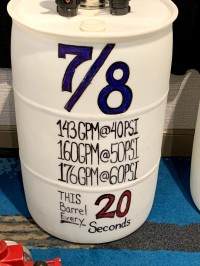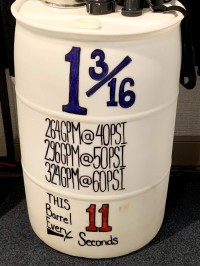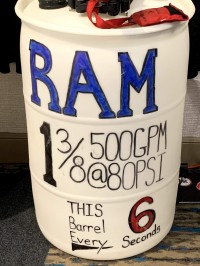 A coordinated fire attack is essential in our modern fire environment where fires are burning hotter and faster than ever with our synthetic home furnishings. Civilian lives are depending on the synchronized actions of firefighters to remove heat and improve their oxygen-deficient atmosphere. Together the fire conditions and civilian lives present tremendous challenges for the incident commander and the nozzle firefighter that at times will require you to listen to that voice inside called gut instinct.
A coordinated fire attack is essential in our modern fire environment where fires are burning hotter and faster than ever with our synthetic home furnishings. Civilian lives are depending on the synchronized actions of firefighters to remove heat and improve their oxygen-deficient atmosphere. Together the fire conditions and civilian lives present tremendous challenges for the incident commander and the nozzle firefighter that at times will require you to listen to that voice inside called gut instinct.

Oscar Armstrong
County Fire Tactics asks you to take a moment of pause while reading this article to remember the loss of Firefighter Oscar Armstrong II 18 years ago today, March 21st, 2003. In March 2003, Firefighter Armstrong was assigned to the nozzle position when his life suddenly ended in a flashover during a residential fire at 1131 Laidlaw Avenue in the Bond Hill section of Cincinnati Ohio. At the time of his death, he was 25 years old and left behind two children, and a fiance expecting the birth of another child.
 When the incident commander arrives on the scene, regardless of rank or vehicle style, the framework for the overall success of the fire begins with the scene size-up, selection of the tactics that will put out the fire based on manpower available, and the tempo at which the tactics are carried out. The photo shows smoke coming from a one-story wood frame with a central hallway leading from the front to the rear. This older home is sealed up tight, boarded up windows, and a damaged roof tarped with furring strips. A gut instinct by the IC drove a slightly slower tempo in recognizing the potential for extreme fire conditions upon opening up this oxygen or ventilation limited fire.
When the incident commander arrives on the scene, regardless of rank or vehicle style, the framework for the overall success of the fire begins with the scene size-up, selection of the tactics that will put out the fire based on manpower available, and the tempo at which the tactics are carried out. The photo shows smoke coming from a one-story wood frame with a central hallway leading from the front to the rear. This older home is sealed up tight, boarded up windows, and a damaged roof tarped with furring strips. A gut instinct by the IC drove a slightly slower tempo in recognizing the potential for extreme fire conditions upon opening up this oxygen or ventilation limited fire.

257 Elm Street Atlanta Georgia
This fire occurred less than six months after Firefighter Steven Solomon lost his life in a fire that occurred on November 23rd, 2006 at 257 Elm Street in Atlanta Georgia. Chief Isakson attended Firefighter Solomon’s funeral and received a first-hand account from an Atlanta Fire Chief regarding the initial conditions and operations where Steven lost his life. Isakson’s gut instinct to slow the tempo and open up before letting his firefighters advance was based on the fire behavior similarities that the two fires presented.

Steven Solomon
The unedited house fire video below shows in real-time how the nozzle firefighter is challenged more than ever to read smoke, understand fire behavior, and prevent rapidly changing fire conditions through the proper application of water with a gallons per second mindset. Gallons Per Second is a firefighter’s primary weapon to level the playing field and defeats the enemy by controlling and reducing the heat, also known as the third leg of the fire triangle. The video also captures the actions of both firefighters and the driver operator confirming proper stretch of the attack lines, proper operational pump discharge pressure, and adequate fire flow to get water on the fire in the right gallons per second.
The time-delayed tactics employed during the operation included utilizing the booster backup concept from the second due unit, and utilizing the third due unit for a sustained water supply. The fire was controlled with only about 1,500 gallons of tank water from the first two engines on scene. Employing actions like these place people before water in support of incident priorities on the modern fire ground.
 During the initial fire attack, the ongoing size up revealed a separate one-bedroom apartment only accessible from the Charlie side of the structure. The line going down the Bravo side continued the interior fire attack in this section of the converted single-family home. Direct water application through interior fire attack allows firefighters to rapidly remove heat, and replace it with oxygen through our fire ground tactics. Water creates and maintains survivable space giving trapped civilians the highest probability of survival. View a related article titled “Gallons Per Second, Creates Survivable Space, 2.50″ Smooth Bore Attack, Water On The Fire”.
During the initial fire attack, the ongoing size up revealed a separate one-bedroom apartment only accessible from the Charlie side of the structure. The line going down the Bravo side continued the interior fire attack in this section of the converted single-family home. Direct water application through interior fire attack allows firefighters to rapidly remove heat, and replace it with oxygen through our fire ground tactics. Water creates and maintains survivable space giving trapped civilians the highest probability of survival. View a related article titled “Gallons Per Second, Creates Survivable Space, 2.50″ Smooth Bore Attack, Water On The Fire”.
As referenced above, from the Nozzle Firefighter to the Fireground Commander, knowledge and understanding of fire behavior and fire dynamics is more important than ever before. By studying ALL of the UL studies we can continue to operate as an aggressive fire service utilizing scientific facts to occupy interior space and improve incident outcomes for civilians and firefighters. Part of this knowledge must include the opportunity for more than one flashover event.

Maurice Bartholomew
While the first room may flash in as little as three minutes and twenty seconds (00:03:20), other compartments within the structure will continue to heat and await additional oxygen as seen in this ventilation limited fire. UL has conducted tremendous fire behavior research in real structures over the past decade. UL’s scientific research indicates the first flashover in a structure occurs between 00:03:20 and 00:04:50 during four experiments under similar conditions from 2009 to 2020. View the newly produced UL fire video.
Fire conditions rapidly evolve and as professionals, we must continue to educate our peers, and superiors on the need for training, proper fire flows, and nozzles capable of punching the fire in the throat. Train and mentor your brother and sister firefighters. This article is written in memory of Maurice Bartholomew, Steven Solomon, Oscar Armstrong, and all firefighters who have died on the nozzle.
Like this:
Like Loading...














 On Friday, April 23rd, 2021, 9:00 am to 12:00 pm, Chief Isakson will ignite the weekend with his popular Engine Company Operations class known as Gallons Per Second.
On Friday, April 23rd, 2021, 9:00 am to 12:00 pm, Chief Isakson will ignite the weekend with his popular Engine Company Operations class known as Gallons Per Second.
 Water is the equalizer in destroying the Fire Triangle. Understanding the Fire Triangle is necessary for successful extinguishment and survival on the fireground. Water application increases survivability for civilians and firefighters alike.
Water is the equalizer in destroying the Fire Triangle. Understanding the Fire Triangle is necessary for successful extinguishment and survival on the fireground. Water application increases survivability for civilians and firefighters alike.  Current building and remodeling practices hinge on energy efficiency creating a significant opportunity for more oxygen-limited fires. When arriving on the scene of a fire presenting with these conditions, we must never forget that water is the equalizer.
Current building and remodeling practices hinge on energy efficiency creating a significant opportunity for more oxygen-limited fires. When arriving on the scene of a fire presenting with these conditions, we must never forget that water is the equalizer. When placing people before water, fireground commanders must understand the importance of rapid attack or fast water from the water supply we bring to the fire in our booster tank and following it up by utilizing the booster backup.
When placing people before water, fireground commanders must understand the importance of rapid attack or fast water from the water supply we bring to the fire in our booster tank and following it up by utilizing the booster backup. While the booster backup tactic will not completely extinguish all fires utilizing two booster tanks, the forward advance of the enemy will slow down while awaiting reinforcements. When in this situation, firefighters must have tactics reinforced through training to establish a sustained water supply.
While the booster backup tactic will not completely extinguish all fires utilizing two booster tanks, the forward advance of the enemy will slow down while awaiting reinforcements. When in this situation, firefighters must have tactics reinforced through training to establish a sustained water supply. Water provides firefighters the most significant opportunity to win the war against the fire, the products of combustion, and the ongoing demolition of structural building components. Water is the equalizer in leveling and destroying the enemy on the field of battle.
Water provides firefighters the most significant opportunity to win the war against the fire, the products of combustion, and the ongoing demolition of structural building components. Water is the equalizer in leveling and destroying the enemy on the field of battle.
 The influence of historical fires on modern fire operations allows firefighters an opportunity to learn from the past. A triple Line of Duty Death (LODD) fire event on March 28th, 1994, now known as
The influence of historical fires on modern fire operations allows firefighters an opportunity to learn from the past. A triple Line of Duty Death (LODD) fire event on March 28th, 1994, now known as 
 Upon arriving at 1940 hours, Ladder 8 noticed smoke from the first-floor apartment of
Upon arriving at 1940 hours, Ladder 8 noticed smoke from the first-floor apartment of 
 A
A 
 When the incident commander arrives on the scene, regardless of rank or vehicle style, the framework for the overall success of the fire begins with the scene size-up, selection of the tactics that will put out the fire based on manpower available, and the tempo at which the tactics are carried out. The photo shows smoke coming from a one-story wood frame with a central hallway leading from the front to the rear. This older home is sealed up tight, boarded up windows, and a damaged roof tarped with furring strips. A gut instinct by the IC drove a slightly slower tempo in recognizing the potential for extreme fire conditions upon opening up this oxygen or ventilation limited fire.
When the incident commander arrives on the scene, regardless of rank or vehicle style, the framework for the overall success of the fire begins with the scene size-up, selection of the tactics that will put out the fire based on manpower available, and the tempo at which the tactics are carried out. The photo shows smoke coming from a one-story wood frame with a central hallway leading from the front to the rear. This older home is sealed up tight, boarded up windows, and a damaged roof tarped with furring strips. A gut instinct by the IC drove a slightly slower tempo in recognizing the potential for extreme fire conditions upon opening up this oxygen or ventilation limited fire.

 During the initial fire attack, the ongoing size up revealed a separate one-bedroom apartment only accessible from the Charlie side of the structure. The line going down the Bravo side continued the interior fire attack in this section of the converted single-family home. Direct water application through interior fire attack allows firefighters to rapidly remove heat, and replace it with oxygen through our fire ground tactics. Water creates and maintains survivable space giving trapped civilians the highest probability of survival.
During the initial fire attack, the ongoing size up revealed a separate one-bedroom apartment only accessible from the Charlie side of the structure. The line going down the Bravo side continued the interior fire attack in this section of the converted single-family home. Direct water application through interior fire attack allows firefighters to rapidly remove heat, and replace it with oxygen through our fire ground tactics. Water creates and maintains survivable space giving trapped civilians the highest probability of survival. 





 The video below shows a mobile home well involved with fire and a back bedroom that had a fully survivable space for occupants. The 2.50″ hose and 1 1/8″ tip in the video punches this fire in the throat. Even though the fire rapidly self-vented from the front windows, the temperature in the rear bedroom never surpassed 100 degrees because the bedroom door was closed, and only had light smoke infiltration.
The video below shows a mobile home well involved with fire and a back bedroom that had a fully survivable space for occupants. The 2.50″ hose and 1 1/8″ tip in the video punches this fire in the throat. Even though the fire rapidly self-vented from the front windows, the temperature in the rear bedroom never surpassed 100 degrees because the bedroom door was closed, and only had light smoke infiltration. Chief Isakson has released the
Chief Isakson has released the 

You must be logged in to post a comment.